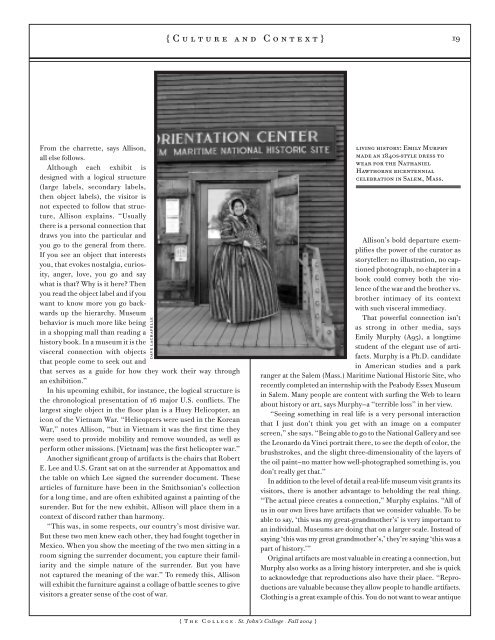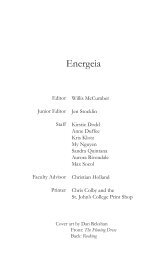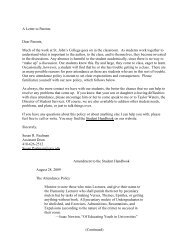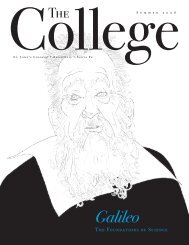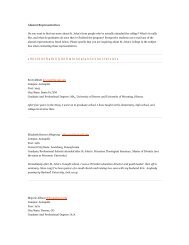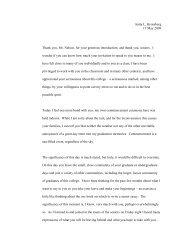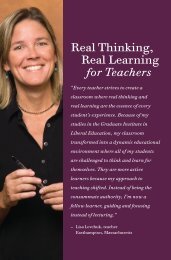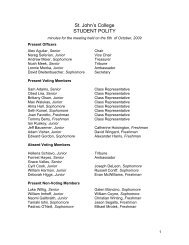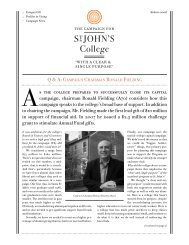Magazine - summer 03 - St. John's College
Magazine - summer 03 - St. John's College
Magazine - summer 03 - St. John's College
You also want an ePaper? Increase the reach of your titles
YUMPU automatically turns print PDFs into web optimized ePapers that Google loves.
{Culture and Context} 19<br />
From the charrette, says Allison,<br />
all else follows.<br />
Although each exhibit is<br />
designed with a logical structure<br />
(large labels, secondary labels,<br />
then object labels), the visitor is<br />
not expected to follow that structure,<br />
Allison explains. “Usually<br />
there is a personal connection that<br />
draws you into the particular and<br />
you go to the general from there.<br />
If you see an object that interests<br />
you, that evokes nostalgia, curiosity,<br />
anger, love, you go and say<br />
what is that? Why is it here? Then<br />
you read the object label and if you<br />
want to know more you go backwards<br />
up the hierarchy. Museum<br />
behavior is much more like being<br />
in a shopping mall than reading a<br />
history book. In a museum it is the<br />
visceral connection with objects<br />
that people come to seek out and<br />
that serves as a guide for how they work their way through<br />
an exhibition.”<br />
In his upcoming exhibit, for instance, the logical structure is<br />
the chronological presentation of 16 major U.S. conflicts. The<br />
largest single object in the floor plan is a Huey Helicopter, an<br />
icon of the Vietnam War. “Helicopters were used in the Korean<br />
War,” notes Allison, “but in Vietnam it was the first time they<br />
were used to provide mobility and remove wounded, as well as<br />
perform other missions. [Vietnam] was the first helicopter war.”<br />
Another significant group of artifacts is the chairs that Robert<br />
E. Lee and U.S. Grant sat on at the surrender at Appomattox and<br />
the table on which Lee signed the surrender document. These<br />
articles of furniture have been in the Smithsonian’s collection<br />
for a long time, and are often exhibited against a painting of the<br />
surender. But for the new exhibit, Allison will place them in a<br />
context of discord rather than harmony.<br />
“This was, in some respects, our country’s most divisive war.<br />
But these two men knew each other, they had fought together in<br />
Mexico. When you show the meeting of the two men sitting in a<br />
room signing the surrender document, you capture their familiarity<br />
and the simple nature of the surrender. But you have<br />
not captured the meaning of the war.” To remedy this, Allison<br />
will exhibit the furniture against a collage of battle scenes to give<br />
visitors a greater sense of the cost of war.<br />
dave lachapelle<br />
living history: Emily Murphy<br />
made an 1840s-style dress to<br />
wear for the Nathaniel<br />
Hawthorne bicentennial<br />
celebration in Salem, Mass.<br />
Allison’s bold departure exemplifies<br />
the power of the curator as<br />
storyteller: no illustration, no captioned<br />
photograph, no chapter in a<br />
book could convey both the violence<br />
of the war and the brother vs.<br />
brother intimacy of its context<br />
with such visceral immediacy.<br />
That powerful connection isn’t<br />
as strong in other media, says<br />
Emily Murphy (A95), a longtime<br />
student of the elegant use of artifacts.<br />
Murphy is a Ph.D. candidate<br />
in American studies and a park<br />
ranger at the Salem (Mass.) Maritime National Historic Site, who<br />
recently completed an internship with the Peabody Essex Museum<br />
in Salem. Many people are content with surfing the Web to learn<br />
about history or art, says Murphy—a “terrible loss” in her view.<br />
“Seeing something in real life is a very personal interaction<br />
that I just don’t think you get with an image on a computer<br />
screen,” she says. “Being able to go to the National Gallery and see<br />
the Leonardo da Vinci portrait there, to see the depth of color, the<br />
brushstrokes, and the slight three-dimensionality of the layers of<br />
the oil paint—no matter how well-photographed something is, you<br />
don’t really get that.”<br />
In addition to the level of detail a real-life museum visit grants its<br />
visitors, there is another advantage to beholding the real thing.<br />
“The actual piece creates a connection,” Murphy explains. “All of<br />
us in our own lives have artifacts that we consider valuable. To be<br />
able to say, ‘this was my great-grandmother’s’ is very important to<br />
an individual. Museums are doing that on a larger scale. Instead of<br />
saying ‘this was my great grandmother’s,’ they’re saying ‘this was a<br />
part of history.’”<br />
Original artifacts are most valuable in creating a connection, but<br />
Murphy also works as a living history interpreter, and she is quick<br />
to acknowledge that reproductions also have their place. “Reproductions<br />
are valuable because they allow people to handle artifacts.<br />
Clothing is a great example of this. You do not want to wear antique<br />
{ The <strong>College</strong> • <strong>St</strong>. John’s <strong>College</strong> • Fall 2004 }


